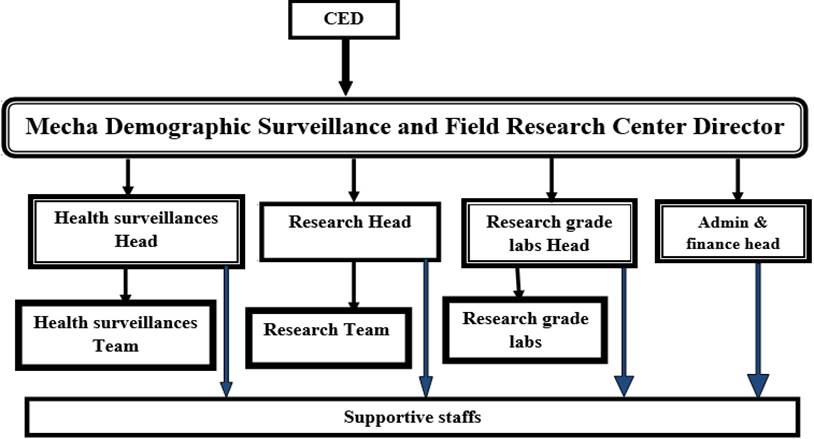Mecha Demographic Surveillance and Field Research Center (MDSFRC) is located in Mecha district of West Gojjam Zone of Amhara Regional State, Northwest Ethiopia. Mecha district is the widest and most Populus district among 18 districts in West Gojjam Zone. The district is located 35 kms Southwest of Bahir Dar City, on the main road of Bahir Dar to Addis Ababa. It has 38 rural and seven urban kebeles with 166 909 km2 area coverage. Over 85% of district area is cultivable and areas within the basins of Koga man-made dam are productive throughout the year. The district has 13 health centers, one general hospital and 37 health posts.
The MDSFRC was established in 2013 with the vision of becoming one of the top ten premier health surveillance and research centers in Africa by 2030. The research center is comprised of three urban and seven rural kebeles (the smallest administrative unit in Ethiopia) that were randomly selected from 38 rural and six urban kebeles of Mecha district. It includes three geo-climatic conditions, namely Dega (high land and cold), Woina (mid land and temperate), and Kolla (low land and hot). The choice was made with the assumption that there would be differences in morbidity and mortality in the different climate area.
The main activities of the center are assessing housing conditions, monitoring demographic altering events such as birth, death, and migration; and health related conditions such as pregnancy and its outcomes, immunization, morbidity, and conducting verbal autopsy to identify the causes of deaths. Conducting problem solving research, participatory community researches and timely dissemination of research and community services outputs to support decision-making practices are also among the main tasks of the research center. During the first census in 20___, a total of ___ households were enumerated and baseline data from all individuals living in these households were collected. Four consecutive rounds of data collection were conducted in 20--, 20--, 20—and 20—in a biannual basis. Currently, a total of ___ households with a total population of ___ are under follow-up.

Figure 1: Map of Macha with randomly selected kebeles for Mecha DSFRC, 2020.
Mission
MDSFRC is committed to improve the health of the population under follow up, enhance evidence -based practices, serve as center of excellence in health and health related research outputs (innovations, products, publications, standards, policy briefs), and generate valid longitudinal data for scientific research, decision making and community services.
Vision
MDSFRC aspires to be become one of the top ten premier health surveillance and research centers in Africa by the end of 2030.
Core values
- Quality data and research
- Ethical practices
- Innovativeness and sustainability
- Community Engagement
- Collaboration
- Transparency and Accountability
- Solidarity
- Inclusiveness
- Team work
Goal
The final goal of MDSFRC is to become center of excellence in health surveillance, research, community services, and generating quality data in the Amhara Region, in Ethiopia, and in Africa at large.
Objectives
- To conduct regular demographic surveillance
- To conduct regular disease surveillance
- To conduct mortality surveillance
- To conduct national and international inclusive innovative longitudinal research across various health and health disciplines
- To generate quality data for scientific research, community services and evidence based decision-making practices
- To improve timely dissemination and utilization of data
- To provide participatory community service on various health and health related events
- To provide training, consultancy and advisory service in generating and handling quality data, health surveillance, research, community services, evidence-based practice, and timely dissemination and utilization of data.
Oregano gram

Services
- Availing any type of sample frame for community-based study
- Consultation
- Supporting on data management and analysis
- Performing surveillances and timely sharing the outputs for action
- Providing trainings and technical supports on handling, data sharing, data analysis, evidence -based decision making, research methodology (quantitative and qualitative), GIS, Ethical practices in research, and the use of internet
- Conducting health and demographic studies
- Delivering participatory community services
- Disseminating the outputs of research and community services to the users through workshops, seminars, publications, guidelines, and policy brief.
